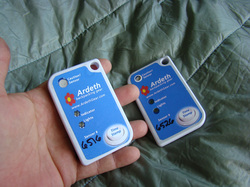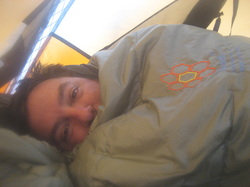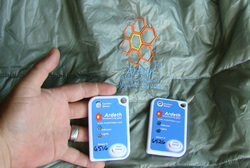
The patent pending test uses credit card sized dataloggers.
When I started building sleeping bags, I found that I could not use the EN 13537 sleeping bag test standard - it was cost prohibitive and provided me with too little data. So, I started reading everything I could get my hand on about how humans generate and retain warmth. I started finding out that the EN 13537 standard just wasn't good enough. I needed something better.
I came to realize that testing a manikin in a laboratory would not provide anywhere near the results that I would get if I tested real people in the real world -- during real backpacking trips. Manikins are nothing like real people; we move, we perspire and, well, we're human -- we get up and down during the night, put on and take off clothing, and adjust our gear for comfort. So I set out to find a test method that would work, and what I found was a relatively simple, inexpensive, and repeatable method that will help us to build -- and buy -- sleeping bags.
I came to realize that testing a manikin in a laboratory would not provide anywhere near the results that I would get if I tested real people in the real world -- during real backpacking trips. Manikins are nothing like real people; we move, we perspire and, well, we're human -- we get up and down during the night, put on and take off clothing, and adjust our gear for comfort. So I set out to find a test method that would work, and what I found was a relatively simple, inexpensive, and repeatable method that will help us to build -- and buy -- sleeping bags.

Testing is done while participants sleep.
When we lay down to sleep on backpacking trips, we started using data loggers to record how warm we were staying inside of our sleeping bags and how cold it got outside. When we got too warm, too cold, changed layers, or unzipped our bags, we'd hit a "time stamp" button on the data loggers, making a notation in the data that would later tell us when we made these changes during the night. The next day, we'd record in a small notebook the reasons we made the time stamps. We also added information about the kinds and weights of the baselayers we were wearing and what type of sleeping pads we used, and we added a data logger outside of our tent to record ambient temperatures. From this information, we started getting an idea about how low a temperature a given bag could perform at when combined with the gear setup we were using.

The dataloggers record temperatures every five minutes.
Most sleeping bag ratings are the result of several series of tests. I want to allow people to test Ardeth bags, along with any other equipment they carry, as many times as they want, even for hundreds of nights. All the test data is recorded and can be combined to build a graph showing how cold conditions the conditions could get outside of a tester's sleeping bag until he or shebecame uncomfortable.
Let's pretend that 1000 bags of a certain model are sold. If 10% of those buyers used the data loggers to test their bags for two nights each, we'd have 200 hundred nights' worth of tests just to get started. I'd say that date might be a far better metric than three tests carried out on manikins on a laboratory bench. And if we profile each of these testers -- and their gear -- we'll begin to see the real-world performance of sleeping bags, baselayers, sleeping pads, and tents.
Here is my introduction to the Sleeping Bag Test Protocol and links to how you can participate.
Let's pretend that 1000 bags of a certain model are sold. If 10% of those buyers used the data loggers to test their bags for two nights each, we'd have 200 hundred nights' worth of tests just to get started. I'd say that date might be a far better metric than three tests carried out on manikins on a laboratory bench. And if we profile each of these testers -- and their gear -- we'll begin to see the real-world performance of sleeping bags, baselayers, sleeping pads, and tents.
Here is my introduction to the Sleeping Bag Test Protocol and links to how you can participate.
 RSS Feed
RSS Feed
